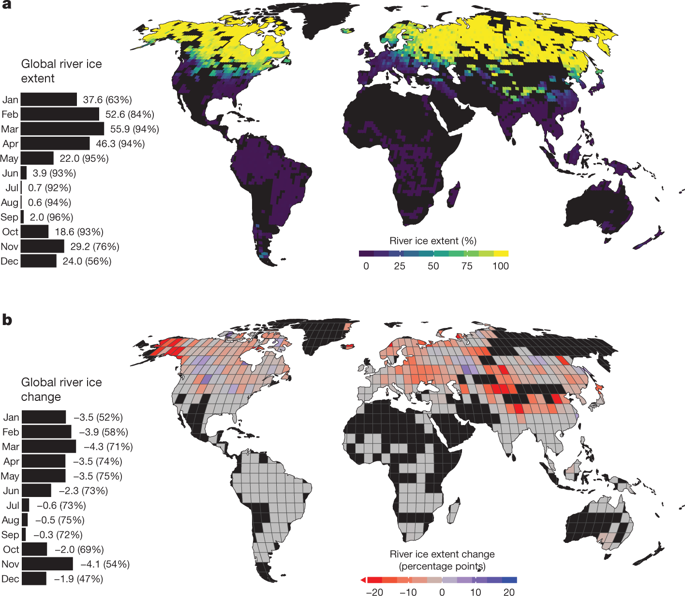Nature ( IF 64.8 ) Pub Date : 2020-01-01 , DOI: 10.1038/s41586-019-1848-1 Xiao Yang 1 , Tamlin M Pavelsky 1 , George H Allen 2

|
More than one-third of Earth’s landmass is drained by rivers that seasonally freeze over. Ice transforms the hydrologic1,2, ecologic3,4, climatic5 and socio-economic6,7,8 functions of river corridors. Although river ice extent has been shown to be declining in many regions of the world1, the seasonality, historical change and predicted future changes in river ice extent and duration have not yet been quantified globally. Previous studies of river ice, which suggested that declines in extent and duration could be attributed to warming temperatures9,10, were based on data from sparse locations. Furthermore, existing projections of future ice extent are based solely on the location of the 0-°C isotherm11. Here, using satellite observations, we show that the global extent of river ice is declining, and we project a mean decrease in seasonal ice duration of 6.10 ± 0.08 days per 1-°C increase in global mean surface air temperature. We tracked the extent of river ice using over 400,000 clear-sky Landsat images spanning 1984–2018 and observed a mean decline of 2.5 percentage points globally in the past three decades. To project future changes in river ice extent, we developed an observationally calibrated and validated model, based on temperature and season, which reduced the mean bias by 87 per cent compared with the 0-degree-Celsius isotherm approach. We applied this model to future climate projections for 2080–2100: compared with 2009–2029, the average river ice duration declines by 16.7 days under Representative Concentration Pathway (RCP) 8.5, whereas under RCP 4.5 it declines on average by 7.3 days. Our results show that, globally, river ice is measurably declining and will continue to decline linearly with projected increases in surface air temperature towards the end of this century.
中文翻译:

全球河冰的过去和未来
地球上超过三分之一的陆地被季节性结冰的河流排干。冰改变了河流走廊的水文1,2、生态3,4、气候5和社会经济6,7,8功能。尽管世界许多地区的河冰范围已显示出下降1,但全球范围内尚未对河冰范围和持续时间的季节性、历史变化和预测的未来变化进行量化。先前对河冰的研究表明,范围和持续时间的下降可归因于气温升高9,10,基于来自稀疏位置的数据。此外,对未来冰层范围的现有预测仅基于 0°C 等温线的位置11. 在这里,使用卫星观测,我们表明全球河流冰的范围正在下降,我们预计全球平均地表气温每升高 1°C,季节性冰持续时间平均减少 6.10 ± 0.08 天。我们使用跨越 1984 年至 2018 年的 400,000 多张晴空 Landsat 图像跟踪了河冰的范围,并观察到过去 30 年全球平均下降了 2.5 个百分点。为了预测河冰范围的未来变化,我们开发了一个基于温度和季节的观测校准和验证模型,与 0 摄氏度等温线方法相比,该模型将平均偏差降低了 87%。我们将此模型应用于 2080-2100 年的未来气候预测:与 2009-2029 年相比,在代表性浓度路径 (RCP) 8.5 下,平均河冰持续时间减少了 16.7 天,而在 RCP 4.5 下,它平均下降 7.3 天。我们的研究结果表明,在全球范围内,河冰正在显着下降,并将随着预计到本世纪末地表气温的升高而继续线性下降。



























 京公网安备 11010802027423号
京公网安备 11010802027423号